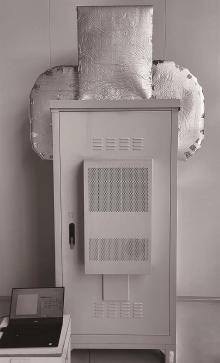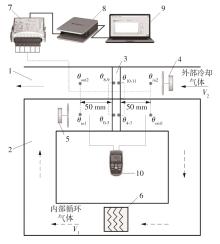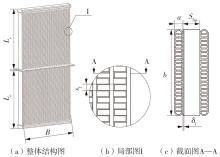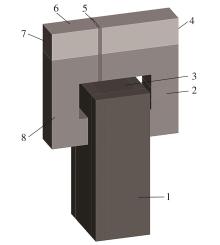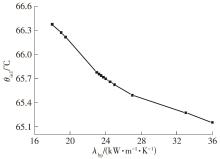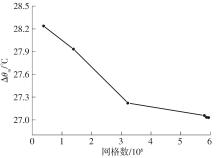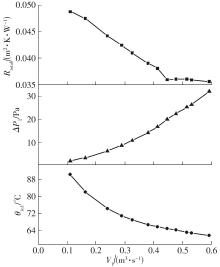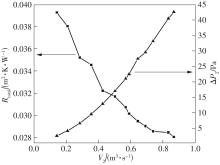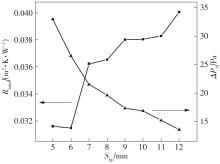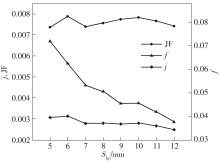Journal of South China University of Technology(Natural Science Edition) ›› 2023, Vol. 51 ›› Issue (3): 13-21.doi: 10.12141/j.issn.1000-565X.220389
Special Issue: 2023年能源、动力与电气工程
• Energy,Power & Electrical Engineering • Previous Articles Next Articles
Performance Analysis of Integrated Micro-Channel Heat Exchanger
GAN Yunhua1 LIU Runxi1 YUAN Hui2 LIU Fengming2 LI Yong3
- 1.School of Electric Power Engineering,South China University of Technology,Guangzhou 510640,Guangdong,China
2.Guangxi Free Trade Zone Jianju Technology Co. ,Ltd. ,Qinzhou 535000,Guangxi,China
3.School of Mechanical and Automotive Engineering,South China University of Technology,Guangzhou 510640,Guangdong,China
-
Received:2022-06-20Online:2023-03-25Published:2022-09-16 -
Contact:甘云华(1979-),男,教授,博士生导师,主要从事微通道传热等研究。 E-mail:ganyh@scut.edu.cn -
About author:甘云华(1979-),男,教授,博士生导师,主要从事微通道传热等研究。 -
Supported by:Guangdong Basic and Applied Basic Research Foundation(2020B1515020040);the Project of Central Guidance and Local Science and Technology Development Fund(Guike ZY22096022)
CLC Number:
Cite this article
GAN Yunhua, LIU Runxi, YUAN Hui, et al. Performance Analysis of Integrated Micro-Channel Heat Exchanger[J]. Journal of South China University of Technology(Natural Science Edition), 2023, 51(3): 13-21.
share this article
| 1 | 雍培,张宁,慈松,等 .5G通信基站参与需求响应:关键技术与前景展望[J].中国电机工程学报,2021,41(16):5540-5551. |
| YONG Pei, ZHANG Ning, Song CI,et al .5G communication base stations participating in demand response:Key technologies and prospects[J].Proceedings of the CSEE,2021,41(16):5540-5551. | |
| 2 | YAO M L, GAN Y H, LIANG J L,et al .Performance simulation of a heat pipe and refrigerant-based lithiu-mion battery thermal management system coupled with electric vehicle air-conditioning[J].Applied Thermal Engineering,2021,196:116878-1-13. |
| 3 | 柏兴应,简弃非,罗立中,等 .均温板在质子交换膜燃料电池堆热管理中的应用[J].华南理工大学学报(自然科学版),2021,49(2):25-32. |
| BAI Xingying, JIAN Qifei, LUO Lizhong,et al .Application of vapor chamber in the thermal management of proton exchange membrane fuel cell stack[J].Journal of South China University of Technology(Natural Science Edition),2021,49(2):25-32. | |
| 4 | GAN Y H, HE L F, LIANG J L,et al .A numerical study on the performance of a thermal management system for a battery pack with cylindrical cells based on heat pipes[J].Applied Thermal Engineering,2020,179:115740-1-10. |
| 5 | 李勇,徐沛恳,杨世凡,等 .吹胀型铝质均热板的传热性能[J].华南理工大学学报(自然科学版),2020,48(2):34-41. |
| LI Yong, XU Peiken, YANG Shifan,et al .Thermal performance of roll bond aluminum vapor chamber[J].Journal of South China University of Technology (Natural Science Edition),2020,48(2):34-41. | |
| 6 | GIBBONS M J,MARENGOM, PERSOONS T .A review of heat pipe technology for foldable electronic devices[J].Applied Thermal Engineering,2021,194:117087-1-26. |
| 7 | ZHOU W J, LI Y, CHEN Z H,et al .Ultra-thin flattened heat pipe with a novel band-shape spiral wovenmesh wick for cooling smartphoness[J].International Journal of Heat and Mass Transfer,2020,146:118792-1-15. |
| 8 | LING L, ZHANG Q, YU Y B,et al .A state-of-the-art review on the application of heat pipe system in data centers[J].Applied Thermal Engineering,2021,199:117618-1-16. |
| 9 | ZHAN B F, SHAO S Q, LIN M, et al .Experimental investigation on ducted hot aisle containment system for racks cooling of data center[J].International Journal of Refrigeration,2021,127:137-147. |
| 10 | WU Y P, JIA J, TIAN D M, et al .Heat transfer performance of microgroove back plate heat pipes with working fluid and heating power[J].Journal of Thermal Science,2020,29:982-991. |
| 11 | YANG C Y, WEBB R L .Condensation of R-12 in small hydraulic diameter extruded aluminum tubes with and without micro-fins[J].International Journal of Heat and Mass Transfer,1996,39(4):791-800. |
| 12 | 葛洋,姜未汀 .微通道换热器的研究及应用现状[J].化工进展,2016,35(S1):10-15. |
| GE Yang, JIANG Weiting .The research progress and application of the micro-channel heat exchanger[J].Chemical Industry and Engineering Progress, 2016, 35(S1):10-15. | |
| 13 | XIONG T, LIU G Q, HUANG S J,et al .Two-phase flow distribution in parallel flow mini/micro-channel heat exchangers for refrigeration and heat pump systems:A comprehensive review[J].Applied Thermal Engineering,2022,201:117820-1-23. |
| 14 | GARCIA J C S, TANAKA H, GIANNETTI N,et al .Multiobjective geometry optimization of microchannel heat exchanger using real-coded genetic algorithm[J].Applied Thermal Engineering,2022,202:117821-1-13. |
| 15 | HARUN-OR-RASHID M, JEONG J H .Replacement of present conventional condenser of household refrigerator by louver fin micro-channel condenser[J].Arabian Journal for Science and Engineering,2019,44:753-761. |
| 16 | XUE L Z, MA G Y, ZHOU F,et al .Operation characteristics of air-air heat pipe inserted plate heat exchanger for heat recovery[J].Energy and Buildings,2019,185:66-75. |
| 17 | ZHANG L Y, LIU Y Y, GUO X,et al .Experimental investigation and economic analysis of gravity heat pipe exchanger applied in communication base station[J].Applied Energy,2017,194:499-507. |
| 18 | SHABGARD H, ALLEN M J, SHARIFI N,et al .Heat pipe heat exchangers and heat sinks:Opportunities,challenges,applications,analysis,and state of the art[J].International Journal of Heat and Mass Transfer,2015,89:138-158. |
| 19 | WANG Y W, DONG T, CAO W J,et al .Experimental investigation of the laminar flow and heat transfer performance of a harmonica tube with or without mini-fins[J].Applied Thermal Engineering,2020,164:114502-1-12. |
| 20 | 张双,马国远,张思朝,等 .热虹吸管换热器的换热性能测试与分析[J].化工学报,2014,65(S2):83-87. |
| ZHANG Shuang, MA Guoyuan, ZHANG Sichao,et al .Heat transfer performance test and analysis of thermosyphon heat exchanger[J].CIESC Journal, 2014, 65(S2):83-87. | |
| 21 | LING L, ZHANG Q, YU Y B,et al .Experimental study on the thermal characteristics of micro channel separate heat pipe respect to different filling ratio[J].Applied Thermal Engineering,2016,102:375-382. |
| 22 | 沈超,刘玉娟,王竹萱,等 .平行流热管管内两相流动可视化实验研究[J].化工学报,2021,72(5):2506-2513. |
| SHEN Chao, LIU Yujuan, WANG Zhuxuan,et al .Visualization experiment of two-phase flow in parallel flow heat pipe[J].CIESC Journal,2021,72(5):2506-2513. | |
| 23 | LEE S, KANG H, KIM Y .Performance optimization of a hybrid cooler combiningvapor compression and natural circulation cycles[J].International Journal of Refrigeration,2009,32:800-808. |
| 24 | XIA G G, ZHUANG D W, DING G L,et al .A quasi-three-dimensional distributed parameter model of micro-channel separated heat pipe applied for cooling telecommunication cabinets[J].Applied Energy,2020,276:115544-1-14. |
| 25 | MENG F X, ZHANG Q, LIN Y L,et al .Field study on the performance of a thermosyphon and mechanical refrigeration hybrid cooling system in a 5G telecommunication base station[J].Energy,2022,252:123744-1-13. |
| 26 | 杨辉著,文键,童欣,等 .板翅式换热器锯齿型翅片参数的遗传算法优化研究[J].西安交通大学学报,2015,49(12):90-96. |
| YANG Huizhu, WEN Jian, TONG Xin,et al .Optimization design for offset fin in plate heat exchanger with genetic algorithm[J].Journal of Xi’an Jiaotong University,2015,49(12):90-96. | |
| 27 | 陶文铨. 数值传热学[M].西安:西安交通大学出版社,2001. |
| [1] | ZHANG Dong, XU Baorui, WANG Sen, et al. Experimental Study of Non-Symmetry Micro Channel Flat Plate Pulsating Heat Pipe Under Variable Conditions [J]. Journal of South China University of Technology(Natural Science Edition), 2023, 51(8): 51-61. |
| [2] | WANG Zhenmin, XIE Huimin, LI Xuyan, et al.. Design and Optimization of Liner TIG Welding Gun for Nuclear Heat Transfer Tube with Small Diameter [J]. Journal of South China University of Technology(Natural Science Edition), 2023, 51(7): 1-11. |
| [3] | ZHOU Linren, LI Shaoji, CHEN Lan. Experimental Investigation into Effect of Surface Roughness on Convective Heat Transfer of Concrete [J]. Journal of South China University of Technology(Natural Science Edition), 2023, 51(7): 81-89. |
| [4] | GAN Yunhua, LIAO Yuepeng, YUAN Hui, et al. Experimental Study on Heat Transfer Performance of Separated Heat Pipe Heat Exchanger in Communication Base Station [J]. Journal of South China University of Technology(Natural Science Edition), 2023, 51(6): 109-118. |
| [5] | XIE Zhihui, LIU Hanyu, WU Jiechang, et al. Numerical Analysis with Thermal-Magnetic-Fluid Coupling on Enhanced Heat Transfer for Shell-and-Tube Heat Exchanger [J]. Journal of South China University of Technology(Natural Science Edition), 2023, 51(3): 22-32. |
| [6] | ZHANG Dong, HOU Hongyi, LI Qingliang, et al. Analysis of Operation Characteristics of Pulsating Heat Pipe Under the Condition of Non-uniform Heat Flux [J]. Journal of South China University of Technology(Natural Science Edition), 2022, 50(7): 126-135. |
| [7] | CHEN Yuanlong, LIN Hua, CHEN Peixuan, et al. Multiphysics Coupling Simulation of ECM Temperature Based on Different Turbulence Models [J]. Journal of South China University of Technology(Natural Science Edition), 2022, 50(3): 88-94,126. |
| [8] | YANG Chen, WANG Fenglei, WU Jiayi, et al. Analysis of Shell-Side Thermal-Hydraulic Performance of Hybrid Smooth and Spirally Corrugated Tubes [J]. Journal of South China University of Technology(Natural Science Edition), 2022, 50(2): 137-144. |
| [9] | WEI Xiaolan, LIN Guoqing, DING Jing, et al. Simulation and Experiment Investigation into Specific Heat Capacity Enhancement of Nitrate Molten Salt Nanofluid [J]. Journal of South China University of Technology (Natural Science Edition), 2021, 49(9): 46-55. |
| [10] | YANG Song, LI Wenqiang, HUANG Xu, et al. Study on Temperature Field of Steel Box Girder Based on Modified Convective Heat Transfer Coefficient [J]. Journal of South China University of Technology(Natural Science Edition), 2021, 49(4): 47-58,64. |
| [11] | HE Boshu, YING Zhaoping, SU Liangbin, et al. Numerical Investigation of Heat Transfer Performance of Molten Salt-Based Nanofluids for Internal Flow#br# [J]. Journal of South China University of Technology (Natural Science Edition), 2021, 49(2): 33-39. |
| [12] | YIN Shugui GUO Weike HUANG Dong ZHANG Huawei WU Houji ZHANG Chunhua. Simulation Study on Heat Transfer Characteristics and Cooling water Design for the Casting Film [J]. Journal of South China University of Technology(Natural Science Edition), 2021, 49(12): 23-34. |
| [13] | YAO Yuan, CHEN Ying, CHEN Jianyong, et al. Experimental Study on Enhanced Heat Transfer Characteristics of Plate Condenser with Liquid-Vapor Separation [J]. Journal of South China University of Technology (Natural Science Edition), 2021, 49(10): 114-122. |
| [14] | YU Xiaodong, GAO Weicheng, WU Guangpeng, et al. Thermal Performance Characterization of Hydrostatic Thrust Bearing Under High Speed and Heavy Load Working Conditions [J]. Journal of South China University of Technology (Natural Science Edition), 2020, 48(9): 79-85. |
| [15] | LI Yong, XU Peiken, YANG Shifan, et al. Thermal Performance of Roll Bond Aluminum Vapor Chamber [J]. Journal of South China University of Technology (Natural Science Edition), 2020, 48(2): 34-41. |
| Viewed | ||||||
|
Full text |
|
|||||
|
Abstract |
|
|||||
